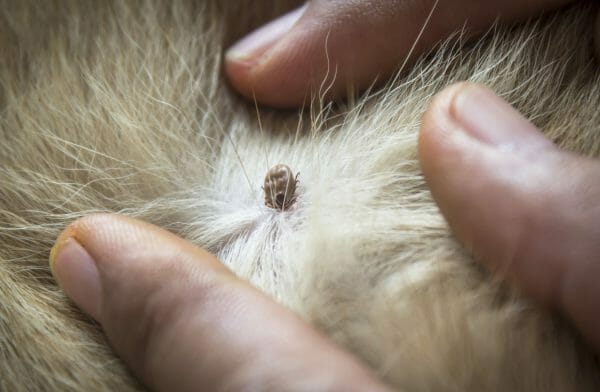What Is the Dog Tick?
As far as ticks on dogs go, the dog tick is the most infamous of its type. Hailing from the arachnid family, the dog tick is unlike other insects with its 8 legs and lack of antennae. All ticks share the same four life cycles of egg, larvae, nymph, and adult.
Once a tick is born, its sole purposes is to feed off the blood of its host and to mate. To find a host, ticks lie in wait on the branches of trees, bushes, and blades of grass. Ticks possess a naturally occurring “glue” that allows them to attach themselves to passing dogs that brush against them. Unless forcibly removed, the ticks remain attached to their new host.
Because ticks are unable to jump or fly, this is their only means of latching onto passing host animals. Once attached, the tick burrows its head in to the skin and allows itself to be filled with blood, causing it to balloon to the size of a pea.

What Are Signs of Ticks on Dogs?
During the months of summer and fall, many pet owners may feel a tinge of dread at the thought of what is known as “tick season.” Ticks thrive in warm weather. Because of this, dog owners that live in areas where the weather is warm almost every day of the year experience larger than normal infestations of ticks in outdoor vegetation. People living in these types of areas should be especially vigilant and proactive in using preventative measures to protect against ticks on dogs.
The first step in determining how to get rid of ticks is learning how to spot them. The dog tick is incredibly small and can be easily passed over during an inspection of your pet’s coat. Because of this, a tick can remain hidden for several days. Matted fur coats or thick coats in general are a tick’s best hiding spot.
One way a tick may make itself known is by infecting a dog with various diseases. Although this does not occur in all cases of ticks, infections such as Lyme disease, anaplasmosis, and Rocky Mountain spotted fever can be carried by ticks.

Some of the primary symptoms of ticks and related infection are:
- Tiny lumps under skin
- Shaking of the head and scratching (can also be a sign of ear mites or fleas)
- Fever
- Scabs or bite marks
- Weakness and changes in activity levels
If these symptoms are observed in your dog, a visit to the vet is highly advised. Although ticks on dogs themselves are not the worst thing that could happen to your pet, a potential infection is a much more serious matter that should not be ignored.
Where Do Ticks Lay Eggs?
Contrary to what some may believe, the answer to the question of “how do ticks reproduce?” does not require a complex and lengthy biology lesson. The answer is quite simple and straightforward.
After feeding off of their host for a long enough time, male and female ticks mate on their host. Once the time comes, new eggs are laid on the ground. The female tick can lay up to 6,000 eggs before dying shortly thereafter. Once the eggs are laid, a new cycle begins anew, and new hosts are soon sought after by the larvae.

Checking Your Dog for Ticks
Before learning how to get rid of ticks, it is crucial for a pet owner to first learn the process of how to check dog for ticks. The ability to recognize a tick can be rather tricky.
A tick burrowed under the skin generally forms a tiny bump that may have a red, scab-like appearance. It is important to remember that ticks in dogs tend to nestle deep into the body parts of the dog that retain the most warmth. Therefore, the following parts of the body should be inspected frequently, especially during tick season:
- Around the eyelids
- Within the groin area
- Within the ears and ear canals
- Around the legs
- Within the paws
It should be noted that ticks on dogs paws are frequent homes to ticks because the paws are on the ground where they can easily pick up ticks from the ground. Ticks in dogs ear and ear canal are common as well, as the ears are often moist and warm. Pet owners might misconstrue an ear infection when it is actually a tick.

How to Kill Ticks on Dogs
In this day and age, there are countless removal methods for how to get rid of ticks. It is usually recommended that if this is a dog’s first time contracting a tick, the canine should be seen by a vet. This is especially true if your dog is exhibiting signs and symptoms of possible infection.
However, most pet owners take it upon themselves to know how to get rid of dog ticks fast. The most common method of removing a tick is to quickly remove the tick with a quick upward pull of tweezers. Despite the fact that this can work, the full body of the tick is not always completely removed. In these cases, a trip to the vet may be necessary. As long as the head of the tick or other body parts are left in the dog, infection remains a risk. In addition to tweezers, there are special tools designed to help pet owners safely and completely remove ticks.

Besides a trip to the vet or physically removing a tick, there are some less invasive methods for those wanting to know how to treat ticks on dogs. For example, a tick collar can be purchased as a preventative measure. Topical medications that also prevent fleas are also available.
When it comes to the best tick medication available, there is some debate. However, some of the more commonly prescribed tick medications taken by mouth are:
- Spinosad
- Nitenpyram
- Fluralaner
- Afoxolaner
- Capstar
Some of these medications kill ticks within hours, while others simply act as preventative measures. Experts recommend consulting with a veterinarian to determine the best tick medication and preventive measures for a specific geographical area. In addition, preventative measures should be used year-round in areas where ticks are prevalent. Websites like Chewy offer a variety of medications and products to prevent ticks on dogs.



